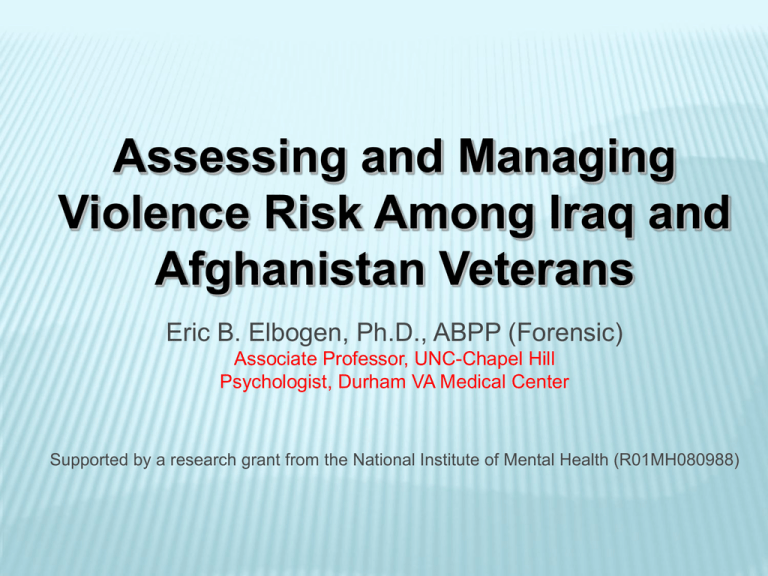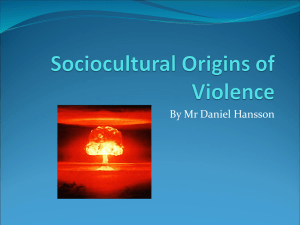
Assessing and Managing
Violence Risk Among Iraq and
Afghanistan Veterans
Eric B. Elbogen, Ph.D., ABPP (Forensic)
Associate Professor, UNC-Chapel Hill
Psychologist, Durham VA Medical Center
Supported by a research grant from the National Institute of Mental Health (R01MH080988)
OBJECTIVES:
1.
2.
3.
List evidence-based components of
anger management interventions.
Conceptualize the process of violence
risk assessment in veterans.
Identify risk factors empirically related to
violence and aggression in veterans.
2
AGENDA:
Key components of violence
management for veterans.
Conceptual framework for conducting
risk assessment of veterans.
Empirically supported factors linked to
aggression among veterans.
Findings on violence from national
survey of OEF/OIF veterans.
3
VIOLENCE IN VETERANS
Media accounts highlight challenges
veterans face in their transition back to
civilian life, resulting sometimes in
anger & aggression.
Recent studies indicate aggression
toward others is a significant problem
reported by up to one-third of Iraq &
Afghanistan War Veterans.
DIMENSIONS OF ANGER
Anger
can be conceptualized as:
Expression
Situational
Symptoms
State vs. Trait
5
ANGER MANAGEMENT
Literature reviews (Del Vecchio & O'Leary, 2004; Saini, 2009)
find:
1. med. to lg. effect sizes across different
modalities for reducing anger problems.
2. cognitive behavioral therapy (CBT) is
best for anger traits.
3. relaxation most effective in reducing
state anger.
6
REDUCING ANGER IN VETERANS
•
One randomized trial of CBT showed
reduced anger among veterans with
PTSD.
•
Another study helped train veterans in
stress inoculation techniques using an
electronic computer guidance approach.
•
Some pharmacological approaches have
reduced anger in veterans, too.
7
COMPONENTS OF ANGER
MANAGEMENT FOR VETERANS
•
Self-monitoring anger frequency, intensity,
& situational triggers.
•
Devising a personal anger provocation
hierarchy based on self-monitoring.
•
Progressive muscle relaxation, breathing
focused relaxation, & guided imagery
training to regulate physiological arousal.
8
COMPONENTS OF ANGER
MANAGEMENT FOR VETERANS
•
Cognitive restructuring of anger by
altering attentional focus, modifying
appraisals, & using self-instruction.
•
Training behavioral coping &
assertiveness skills.
•
Role-playing progressively more intense
anger arousing scenes from personal
hierarchies.
9
DIMENSIONS OF AGGRESSION
Aggression to others varies in terms of:
frequency
severity
victim
use of weapons
circumstances
instrumental vs. reactive
10
RISK ASSESSMENT
Increasing need to improve ability to
detect Veterans at highest risk.
Clinicians perform only modestly better
than chance when assessing risk.
Different types of decision-making
errors clinicians may commit.
11
FINDINGS FROM VISN6 MIRECC
Post-deployment aggressiveness was
associated with Posttraumatic Stress Disorder
(PTSD) hyperarousal symptoms:
sleep
problems
difficulty concentrating
irritability
jumpiness
being on guard
Other PTSD symptoms, as well as TBI, were
less consistently connected.
FINDINGS FROM VISN6 MIRECC
Different Types of Aggressiveness related
to Different Factors:
Problems
Managing Anger linked to
relationships, (e.g., being married).
Aggressive
Impulses/Urges linked to mental
health (e.g., family mental illness).
Problems
Controlling Violence linked to
violence exposure (e.g., witnessing violence,
firing weapon).
RISK ASSESSMENT
Clinicians perform only modestly better
than chance when assessing violence.
Increasing need to improve ability to
detect Veterans at highest risk.
To do so, clinicians should examine
empirically-supported risk factors and
use structured decision-aides or tools.
RISK ASSESSMENT
To reduce errors, clinicians need to
make decision-making more systematic,
using decision-aides or checklists:
To
ensure all important information is
gathered in the course of diagnosis &
treatment
To
reduce chances of overlooking
critical data in time-pressured clinical
practice
15
Dispositional Demographics
Personality/Traits
Military Characteristics
Static
Factors
Historical
Pre-deployment
During deployment
Post Deployment
Clinical
PTSD/TBI (combat)
Other Mental Health/
Medical Problems
Contextual
Financial/Work
Family/Social Support
VA Health Services
Individual
Factors
Dynamic
Factors
Violence Risk Assessment for
Veteran Populations
Situational
Factors
RISK FACTORS IN VETERANS
Risk Domain
Dispositional
Risk Factors for
Intimate Partner/
Domestic Violence
Younger age
Related
to Both
Types of
Violenc
e
Risk Factors for
General Interpersonal
Violence
Younger age
Lower education level
Historical
Past violent behavior
Combat Exposure
(atrocities, perceived
threat)
Chaotic family life
growing up
Maltreatment/Abuse
as a Child
Past violent behavior
Combat Exposure
(killing/seeing killings)
Witnessed violence
growing up
Abuse/maltreatment as a
child
RISK FACTORS IN VETERANS
Risk
Domain
Risk Factors for
Intimate Partner/
Domestic Violence
Clinical
Meets criteria for PTSD
Severe PTSD Symptoms
Substance abuse
Depression
Personality Disorder
Contextual
Financial Status
(Unemployment)
Marital/relationship
problems
Shorter/newer marriages
Children in the home
Related
to Both
Types of
Violence
Risk Factors for
General Interpersonal
Violence
Meets criteria for PTSD
Severe PTSD Symptoms
Substance abuse
Depression
Traumatic Brain Injury
(TBI)
Higher levels of anger
Financial Status
(Lower Socio-Economic
Status & income)
NATIONAL OEF/OIF VETERANS STUDY
May 2009, a random sample of 3000 names /
addresses drawn by the VA Environmental
Epidemiological Service of the over one million
U.S. active duty & military reservists who served in
military on or after September 11, 2001.
In total, N=1388 OEF/OIF military service members
completed a web-based survey on postdeployment adjustment, representing a 56%
corrected response rate.
NATIONAL OEF/OIF VETERANS STUDY
The resulting sample included Iraq &
Afghanistan War service members and
Veterans from all branches of the military &
the reserves.
Participants resided in all 50 states,
Washington D.C., & four territories.
Responders were similar to non-responders
in age, gender, & geographic region.
INDEPENDENT VARIABLES
Demographics: education, age, gender, race,
income.
Historical: witnessing family violence, physically
punished as child, history arrest (veteran/family).
Military: rank, NDHS combat experiences, length
and number of deployments.
Clinical Diagnosis: PTSD (Davidson Trauma
Scale), alcohol misuse (AUDIT), Traumatic Brain
Injury (TBI), major depression (PHQ9).
Functional Domains: work, homelessness, ability to
pay for basic needs, back pain, sleep problems,
resilience (CD-RISC), social support.
DEPENDENT VARIABLES
Severe Violence (past year)
Conflict Tactics Scale: “Used a knife or gun”, “Beat
up the other person”, or “Threatened the other
person with a knife or gun”
MacArthur Community Violence Scale: “Did you
threaten anyone with a gun or knife or other lethal
weapon in your hand?”, “Did you use a knife or
fire a gun at anyone?”, “Did you try to physically
force anyone to have sex against his or her will?”
Physical Aggression (past year)
Other items indicating physical aggression
including kicking, slapping, &using fists.
DEMOGRAPHIC DATA
We oversampled women veterans (33%)
& weighted analyses according to actual
military figures (12%).
Average age - 33 years.
Slightly less than one-half reported posthigh school education (45%).
70% were Caucasian.
78% reported some current employment.
HISTORICAL / MILITARY DATA
7% reported witnessing parental violence.
10% reported a history of arrest before
deployment.
16% ranked officer or higher.
27% reported spending more than a year
in Iraq/Afghanistan.
27% reported more than one deployment.
Average time since deployment 4.5 years.
CLINICAL / CONTEXTUAL DATA
20% met criteria for PTSD on the Davidson
Trauma Scale.
15% reported Mild Traumatic Brain Injury.
2% reported moderate to severe TBI.
27% met criteria for alcohol misuse.
24% met criteria for major depressive
disorder.
VIOLENCE / AGGRESSION
11% reported incidents Bivariate analyses
of severe violence in the indicates both linked to:
past year.
Younger Age
32% reported incidents
Combat Involvement
of less severe physical
Depression
aggression in the past
Alcohol Misuse
year.
PTSD
mTBI
Arrest History
VIOLENCE AND FUNCTIONING
n
Domains
Sleep Problems
No
Yes
Basic Needs Met
Yes
No
Resilience
Above Median
Below Median
Social Support
Satisfied
Not Satisfied
Violent n
%
c2
p-value
796
305
60
58
7.58
19.06
30.28
<.0001
646
455
47
71
7.33
15.65
19.29
<.0001
562
538
45
73
8.10
13.55
8.49
0.0036
654
447
46
72
7.06
16.19
23.04
<.0001
VIOLENCE AND FUNCTIONING
n
Domains
Back Pain
No
Yes
Homeless Past Year
No
Yes
Work Past Year
Yes
No
Violent n
%
c2
p-value
659
442
49
69
7.48
15.67
18.45
<.0001
1051
50
100
18
9.52
36.0
36.87
<.0001
862
239
77
41
8.96
17.25
13.43
0.0002
MULTIVARIATE: SEVERE VIOLENCE
OR
CI
p
Age
1.647
0.928-0.985
0.003
Sex
0.956
0.819-3.309
0.161
Race
0.699
0.447-1.093
0.116
Physical & Mental Injury/Distress1
2.754
1.671-4.539
<.001
Economic & Social Attainment2
0.8
0.628-1.019
0.070
Combat Exposure3
1.467
0.935-2.301
0.095
Family History4
1.359
0.668-2.761
0.397
2.941
1.681-5.148
<.001
0.896
0.556-1.445
0.653
Criminal /Risk Behaviors
Support and Resilience6
5
R2=.21, AUC=.81, c2= 124.52, df=9, p<.0001
Cluster 1: PTSD, Depression, Sleep, Back Pain, mTBI.
Cluster 2: Education, Income, Married, Money to Cover Basic Needs, Reserves,Rank>Officer, Employed.
Cluster 3: Multiple Deployments, Over a Year Deployed, NDHS Combat Exposure Scale>median.
Cluster 4: History of Witnessing Family Violence, Physical Punishment, Parental Criminal Arrest History
Cluster 5: History of Criminal Arrest, Homeless in Past Year, Alcohol/Drug Misuse.
Cluster 6: CD RISC score>median, QLI scored satisfied with family/friend support.
MULTIVARIATE: OTHER AGGRESSION
OR
CI
P
Age
0.971
0.955-0.988
0.0007
Sex
0.872
0.584-1.3
0.5005
Race
0.882
0.644-1.206
0.4302
Physical & Mental Injury/Distress1
1.976
1.377-2.834
0.0002
Economic & Social Attainment2
0.841
0.714-0.99
0.0373
Combat Exposure3
1.511
1.102-2.074
0.0105
Family History4
1.359
0.816-2.264
0.239
2.39
1.533-3.726
0.0001
0.527
0.388-0.718
<.0001
Criminal /Risk Behaviors
Support and Resilience6
5
R2=.20, AUC=.75, c2= 184.27, df=9, p<.0001
Cluster 1: PTSD, Depression, Sleep, Back Pain, mTBI.
Cluster 2: Education, Income, Married, Money to Cover Basic Needs, Reserves, Rank>Officer, Employed.
Cluster 3: Multiple Deployments, Over a Year Deployed, NDHS Combat Exposure Scale>median.
Cluster 4: History of Witnessing Family Violence, Physical Punishment, Parental Criminal Arrest History
Cluster 5: History of Criminal Arrest, Homeless in Past Year, Alcohol/Drug Misuse.
Cluster 6: CD RISC score>median, QLI scored satisfied with family/friend support.
PREDICTED PROBABILITY OF VIOLENCE
Protective factors connote adaptive levels of functioning in the following
domains: living, work, financial, psychological, physical, social.
EFFECT OF CONTEXT ON LINK BETWEEN
COMBAT EXPOSURE AND VIOLENCE
32
DISCUSSION
Findings reveal a subgroup of veterans who report
recent serious violence such as use of a weapon
or beating another person (11%); however, a
higher number of veterans report physically
aggressive incidents such as shoving or pushing
others (32%).
Factors related to violence among veterans from
previous eras and wars — age, alcohol misuse,
PTSD, depression, combat exposure— had
significant empirical association among Iraq and
Afghanistan Veterans.
DISCUSSION
Not related to violence or aggression in either
multivariate model: sex, race, witnessing family
violence.
In addition to treating mental health and substance
abuse problems, promising rehabilitation
approaches to reduce violence risk would target
domains of:
basic functioning (living, financial, vocational)
well-being (social, psychological, physical)
SUMMARY
Assess for Veteran’s individual definition of
anger problems.
Treat anger according to evidence based
components.
Assess violence risk in a structured way
relying on empirically supported risk
factors.
Stay current on research on variables
related to violence in OEF/OIF Veterans.
35









